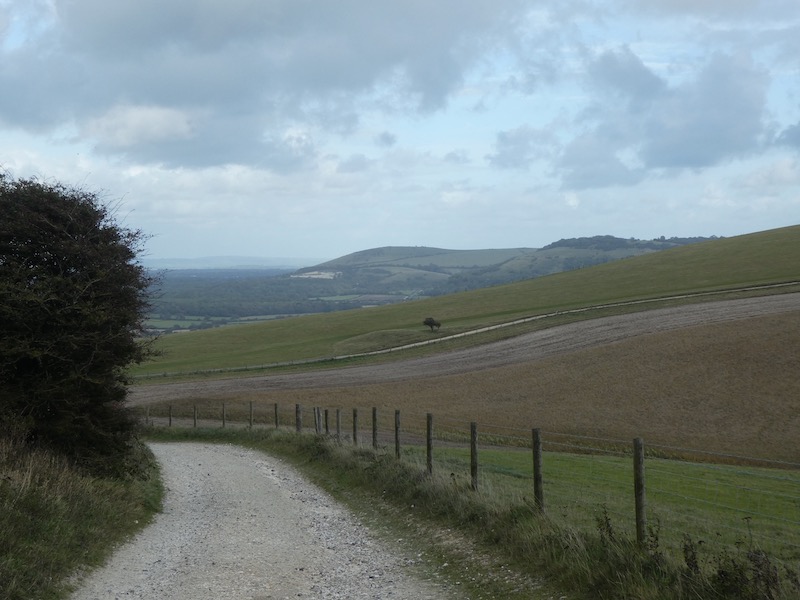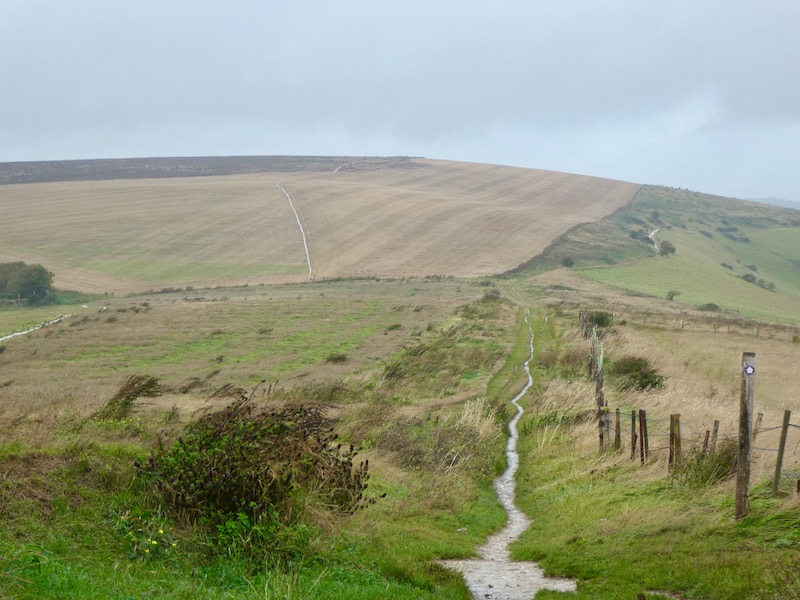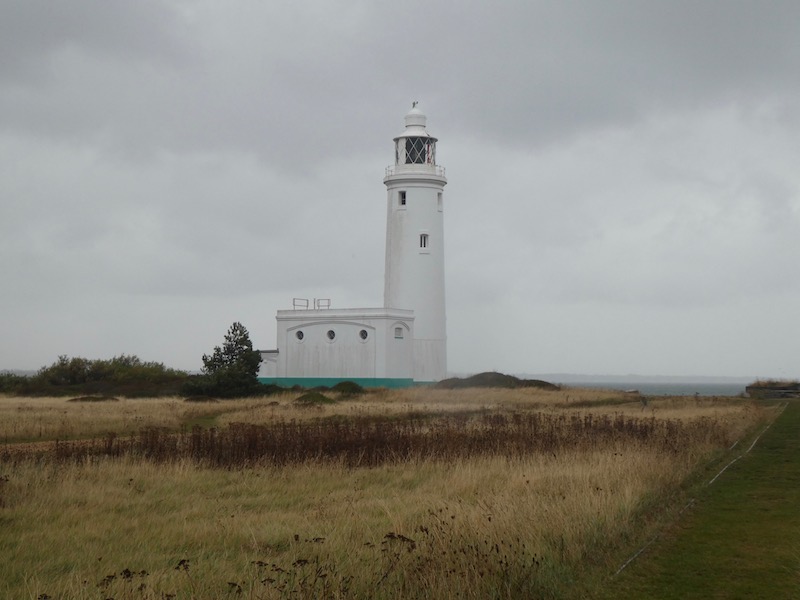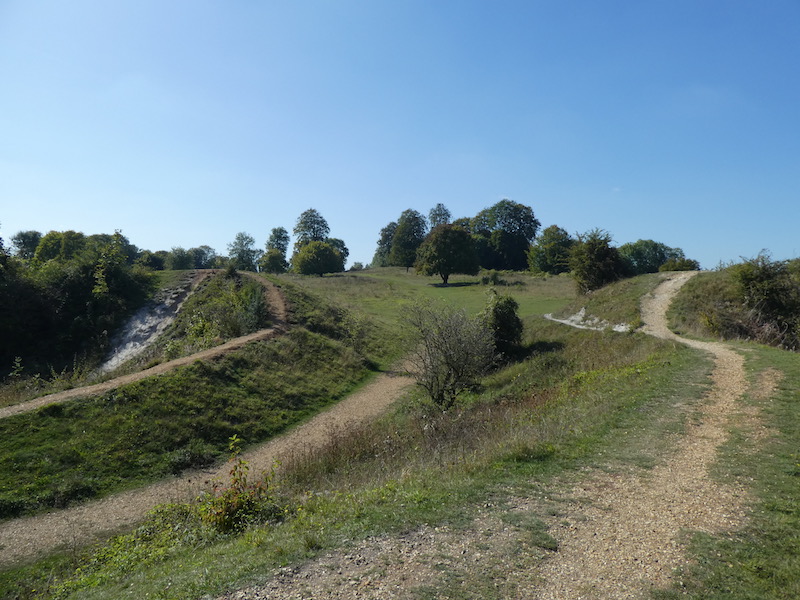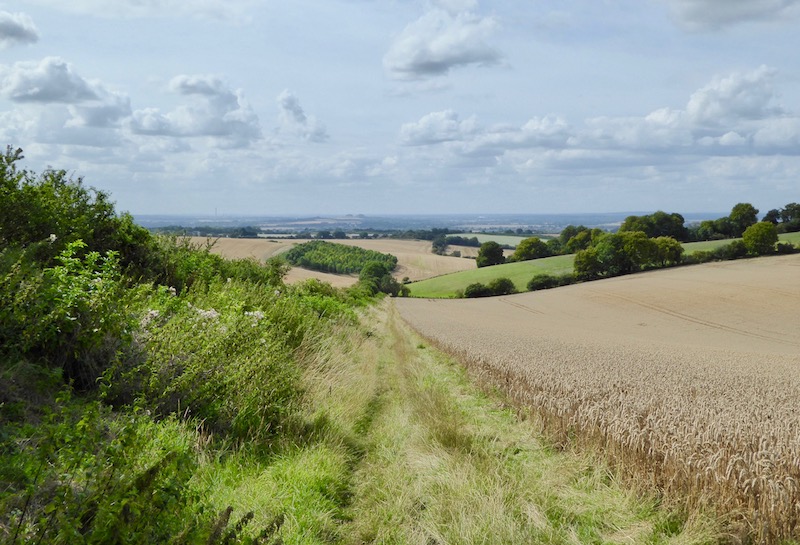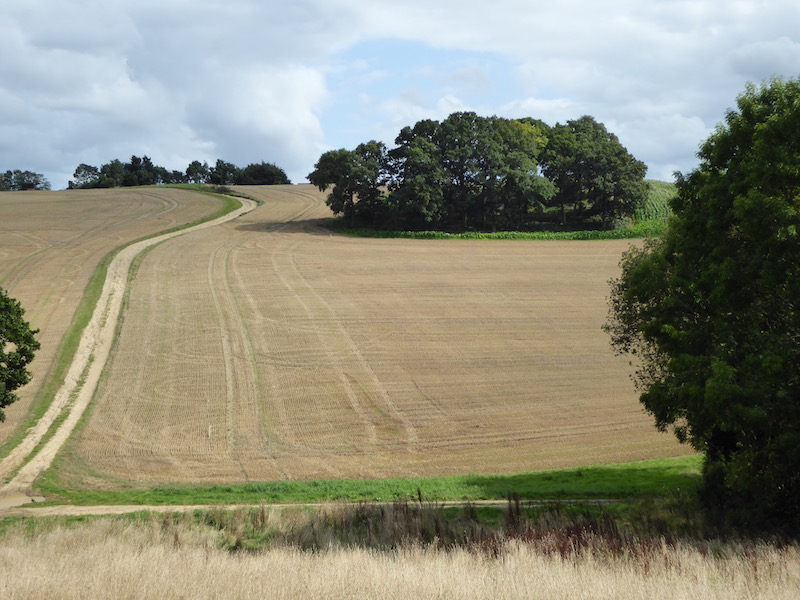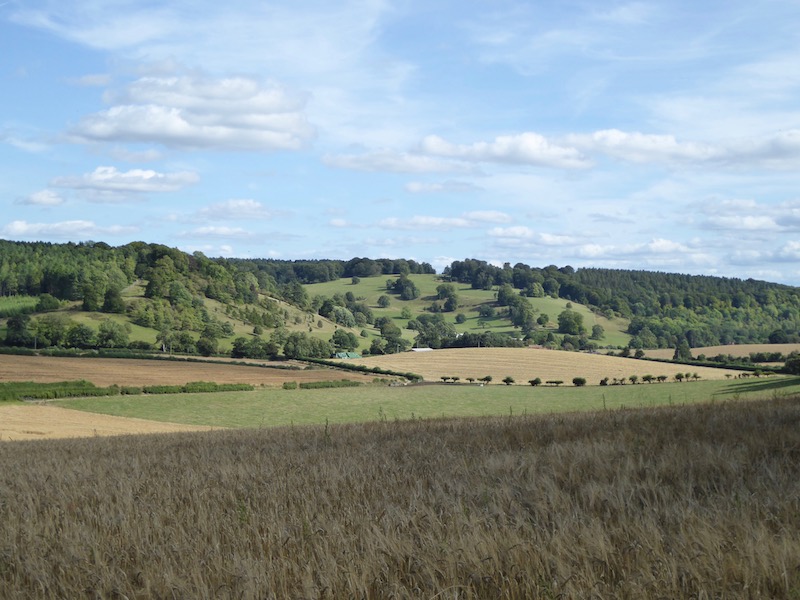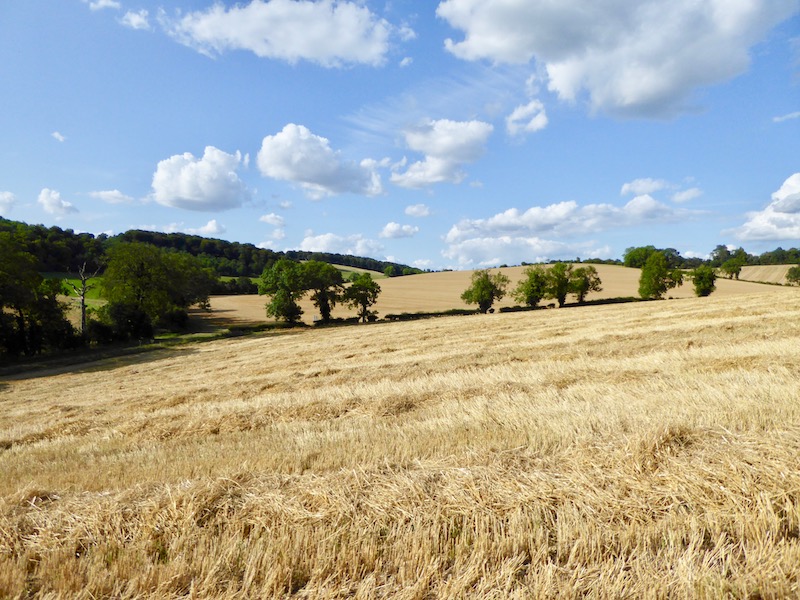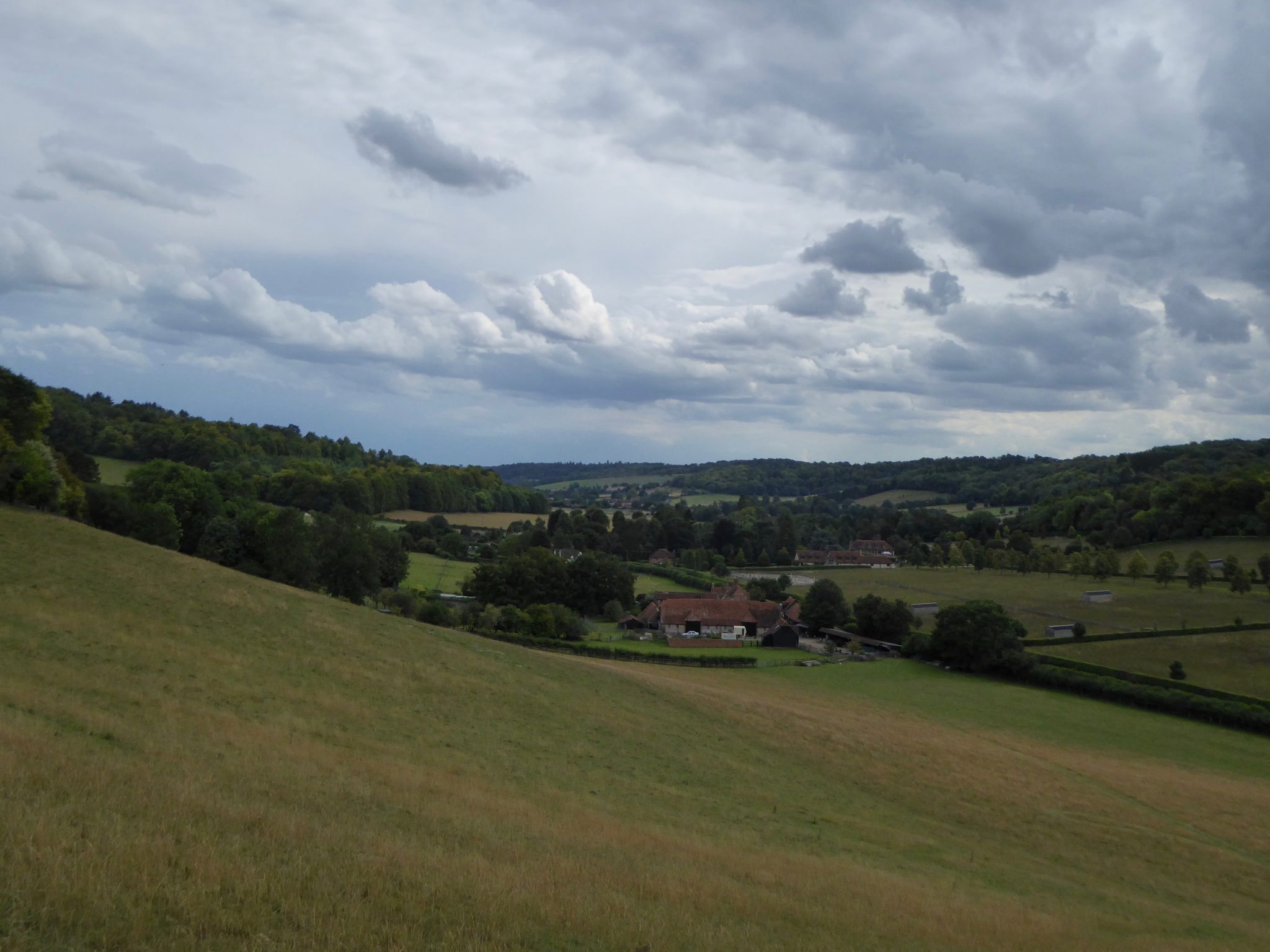One of the benefits of walking on the South Downs are the extensive network of tracks and footpaths in the area. Many of these routes are ancient byeways and the area is littered with old settlements and burial mounds.
Today the starting point for my walk is a car park (Grid Reference TQ273093) on the Devils Dyke Road close to the entrance to the Brighton and Hove Golf Club. Leaving the car park I pick up the footpath running parallel to the road and head north westerly to reach a crossing of paths. Here I turn left and cross the road to join the driveway of the Golf Club.

After passing the club car park I have an option of paths, I follow the route of the Monarch’s Way which follows a hedge line besides a field.

The Monarch’s Way is a 625-mile trail roughly following the route taken in 1651 by King Charles II after the defeat of Worcester. It starts in Worcester and ends in Shoreham-by-Sea. Part of the route runs close to where we live in Wiltshire. It is a trail I would like to tackle at some point, but finding the time to walk 625 miles in one go will be challenge.

I stay with the trail as it crosses footpaths on Benfield Hill before heading down through an area of farmland dominated by horse paddocks.

The track leads through stables and then heads uphill towards a bridge crossing the A27. Just before the bridge I turn right on a track, still following the route of the Monarch’s Way. I have a clear views of the route I have taken since leaving the Brighton and Hove Golf Club.

After a quarter of a mile the Monarch’s Way goes left off the main track, here I continue heading north to reach the site of an old dewpond. These ponds are common sites on chalk downland. They were built to provide livestock with water. The chalk means natural ponds do not form so these shallow pits were dug and lined with a mixture of clay and straw, beneath which there is a layer of lime to prevent worms from puncturing the clay. An upper layer of flints means the hooves of the livestock do not pierce the clay.

Continuing along the track I pass the Ordnance Survey trig pillar on Mount Zion. This is a trig I have previously bagged so not one I can add to my list.

About half a mile after passing the trig pillar I leave the path and turn left along a track, now on the route of the Sussex Border Path.

In the distance to the north I can see the aerial masts at Truleigh Hill. I will be passing there later in the day.

I pass Mile Oak Dew Pond in a field to my right.

At a fork in the track I go right, staying with the Sussex Border Path, I head downhill to a junction of paths and turn right before quickly turning left to enter access land on Southwick Hill.

I proceed up the hill. At a fork in the path I go right to cross the summit of the hill, the A27 runs below this hill in the Southwick Tunnel. The tunnel was constructed in 1996 and it contains a number of “service doors”, there has been much speculation locally as to the purpose of these doors with suggestions they provide access to large underground secret military bunkers.
I continue in a southwesterly direction across the access land to reach a track, which I stay on heading steadily downhill, this is a slight detour with the purpose of visiting the Rest and be Thankful Stone. The stone is located just off the track close to a fence. This is a block of sarsen stone that was originally part of Southwick Church but moved here in the 19th century to be used a as boundary stone. It is thought that its name derives from its location on the hill besides the track and its shape akin to a seat.

From the stone I turn around and retrace my steps back up the hill and follow the track that heads initially north and then north westerly to reach an Ordnance Survey trig pillar, this is the 175th I have bagged.

A short distance after passing the trig I take a path on the left which heads west towards Mossy Bottom Barn.

From this track I get a good view out to sea.

The path takes me by Mossy Bottom Barn and then onto Erringham Farm before reaching a minor road. Here I turn left to make a diversion to bag the trig point on Mill Hill. This is a trig located on private land and there is no obvious easy access so I have to be content with taking a picture of my 176th trig from the edge of the field.

I now turn around and head north on the road, this leads close to the eastern edge of the Beeding Cement Works before continuing on to the car park on Beeding Hill. As I approach the car park I pass Anchor Bottom to my left.

At a junction of six paths I go right on the South Downs Way, the path runs besides a minor road heading to the Youth Hostel on Truleigh Hill. I walked this path last year whilst travelling the South Downs Way and it has some fine views.

My route is now easy to navigate, I follow the route of the South Downs Way heading east towards Devils Dyke. This is a cracking section of the South Downs Way, the views are stunning.

The path undulates as it crosses Edburton Hill, Perching Hill and Fulking Hill. It is wonderful chalk downland walking, with cracking views in every direction.

There are a busy network of paths around Fulking Hill. I stay with the South Downs Way, but after going through a gate I veer to the right to leave the National Trail and follow a path heading towards Devil’s Dyke Road. To my left I can see the Devil’s Dyke OS trig pillar, this is one I have bagged previously.

On reaching the road I join a permissive path running parallel to the road with the Dyke Golf Club to my left.

I stay on the path back to the car park where I started my walk. I have covered 15 miles, it has been a cracking walk with some stunning views.
You can view this 15 mile walk on OS Maps and download the GPX File Here
To follow my walk you will need Ordnance Survey Explorer Map OL11 – Brighton & Hove
28th September 2019
© Two Dogs and an Awning (2019)
All information on this site is provided free of charge and in good faith and no liability is accepted in respect of damage, loss or injury which might result from it. To the best of my knowledge the routes are entirely on public rights of way or within areas that are open for public access.
Walking can be hazardous and is done entirely at your own risk. It is your responsibility to check your route and navigate using a map and compass.
